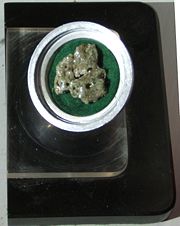Trinitite — Trinitite, also known as Atomite or Alamogordo Glass, is the name given to the glassy residue left on the desert floor after the plutonium based Trinity nuclear bomb test July 16, 1945, near Alamogordo, New Mexico. The glass is primarily composed … Wikipedia
trinitite — trin·i·tite (trĭnʹĭ tīt ) n. An olive green, glasslike substance formed from the sand melted by the heat that was generated by the first nuclear blast at the New Mexico test site in 1945. [After theTrinity Site in New Mexico, after Trinity,… … Universalium
trinitite — noun The glassy residue left on the desert floor after the nuclear bomb test of 1945 … Wiktionary
Plutonium in the environment — is an article which is part of the actinides in the environment series. Almost all plutonium present in the environment is due to human activity because the majority of plutonium isotopes are shortlived on a geological timescale.… … Wikipedia
Environmental radioactivity — is produced by radioactive materials in the human environment. While some radioisotopes, such as strontium 90 (90Sr) and technetium 99 (99Tc), are only found on Earth as a result of human activity, and some, like potassium 40 (40K), are only… … Wikipedia
Trinity (nuclear test) — For other uses, see Trinity (disambiguation). Trinity The Trinity explosion, 0.016 seconds after detonation. The fireball is about 600 feet (200 m) wide. The black specks silhouetted along the horizon are trees. Information Country… … Wikipedia
Manhattan Project — This article is about the atomic bomb project. For other uses, see Manhattan Project (disambiguation). Manhattan District The Manhattan Project created the first nuclear bombs. The Trinity test … Wikipedia
Lechatelierite — is silica glass, amorphous SiO2. One common way in which lechatelierite forms naturally is by very high temperature melting of quartz sand during a lightning strike. The result is an irregular, branching, often foamy hollow tube of silica glass… … Wikipedia
Desert glass — There are various types of natural glass found in deserts. Desert glass can be formed from the silica in sand as a result of lightning strikes or meteor impacts. Libyan desert glass in Egypt and Libya Edeowie glass in South Australia Darwin glass … Wikipedia
List of World War II topics (T) — # T 26 # T 27 # T 28 Super Heavy Tank # T 28 # T 34 variants # T 34 # T 35 # T 37 tank # T 38 tank # T 40 # T 43 tank # T 44 # T 50 tank # T 6 Texan variants # T 6 Texan # T 60 tank # T 70 # T G Building, Brisbane # T. E. Burridge # T. H. Jordan… … Wikipedia

